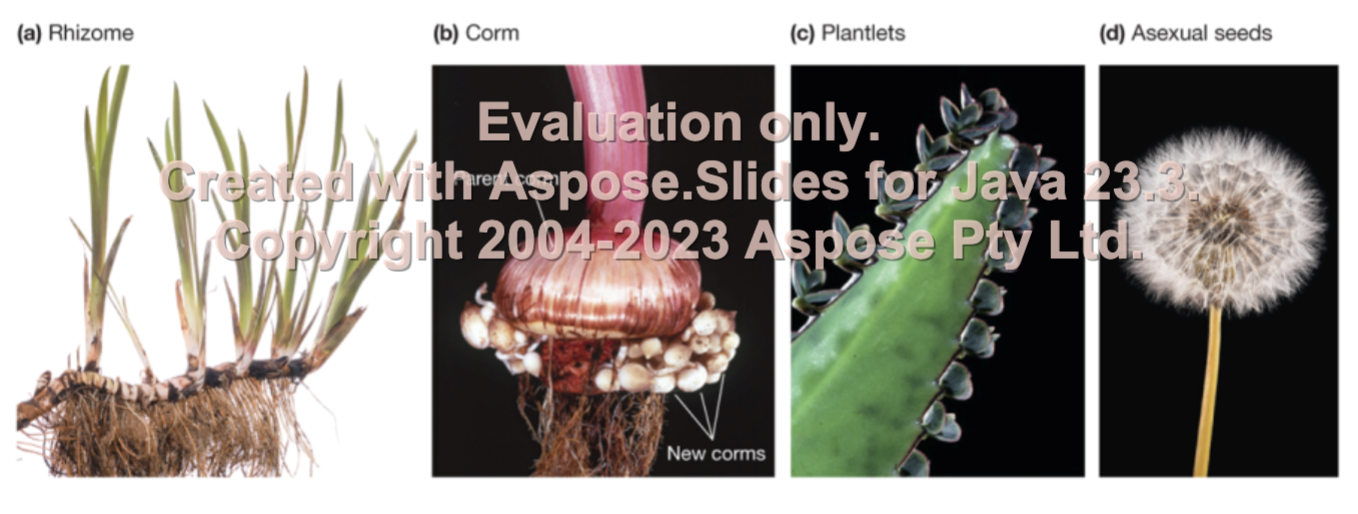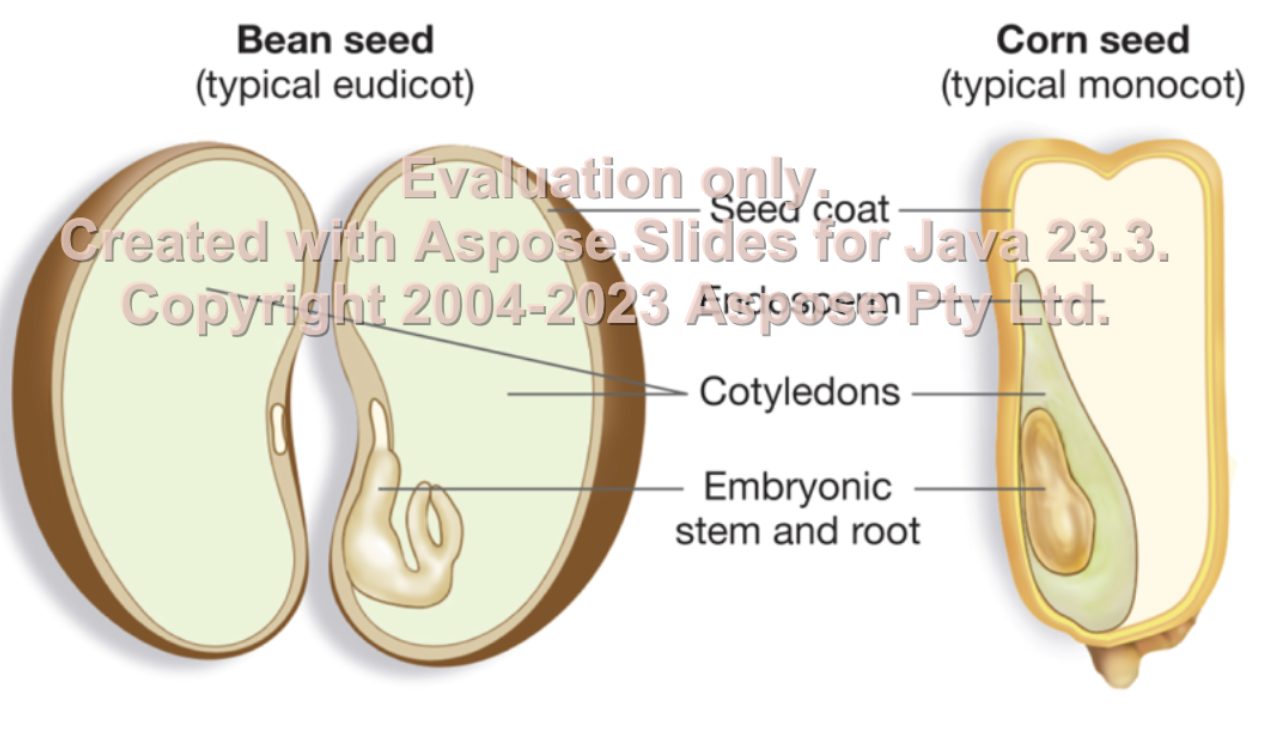Plant Reproduction
1/35
There's no tags or description
Looks like no tags are added yet.
Name | Mastery | Learn | Test | Matching | Spaced |
|---|
No study sessions yet.
36 Terms
mechanisms by which flowering plants reproduce asexually
vegetative propagation, division, budding
flowers, seeds, fruits
flowers: produce gametes, attract pollinators, nourish embryos, develop seeds and fruit
seeds: embryo, stores nutrients, protective coat
fruits: develop into flower and contain seeds
plant asexual reproduction- rhizomes, corms, plantlets,
produce clones
rhizomes: horizontal stem which roots and shoots emerge
corms: modfied stems which grow under surface of soil
plantlets: form along margins of plant leaves

apoxmixis
mature seeds can from without ferilziaiton
downside of asexual reproduction
disease causing agents infect platns offspring
lack genetic diversity to generate disease fighting
sexual reproduction;
meiosis and fertilization
produce genetically different offspring
life cycle of land plant- angiosperms
meiosis occurs in sporophytes, sporangia produce
sepal function, entire group of sepals is called
attached to receptacle in whorl, enclose and protect flower bud as it grows, calyx
corolla
group of petal in flower
wind pollination
angiospersm (oaks, birches, grasses) have small petals/ no petals
wind polinated species lack nectaries, do not invest in strcitures that are not
imperfect flowers
contain either stames or carpels, not both
monoecious plants
separate male and female reproductive organs on the same individual plant (corn)
diocieious plant
cannabis- produce only male or female flowers
how are female gametophytes produced
. Ovule Structure
Each ovule is located inside the ovary of a carpel (female reproductive organ of a flower).
Within each ovule is a diploid (2n) cell called the megasporocyte (or megaspore mother cell), located inside a tissue called the megasporangium (also known as the nucellus).
2. Meiosis of the Megasporocyte
The megasporocyte (2n) undergoes meiosis, a type of cell division that reduces the chromosome number by half.
This results in four haploid (n) megaspores, but typically only one survives; the other three degenerate.
3. Development of the Female Gametophyte (Embryo Sac)
The surviving megaspore undergoes three rounds of mitosis, producing eight haploid nuclei.
These nuclei are arranged into a seven-celled structure known as the mature embryo sac (female gametophyte).
4. Structure of the Mature Embryo Sac
Three antipodal cells at the chalazal end.
Two synergid cells and one egg cell at the micropylar end.
One central cell with two polar nuclei in the center.
ovary vs ovule
ovary contains the ovules, develop into a fruit after fertilization.
ovules, which are located inside the ovary, develop into seeds
outcrossing
sperm and eggs from diff individuals combine, results from cross pollinations
more genetically diverse
selfing
successful pollination all time
offspring are less genetically diverse
how plants prevent selfing
temporal avoidance: male and female gametophyte within perfect flower mature at different times
spatial avoidance: dioecious species w perfect flowers have anthers and stigmas so par apart, self pollination unlikely
molecular matching: plants recognize self and non self tissues= self incompatible
pollination syndromes: bird, moth
suites of flower associated with certain types of pollinators
birds: red, unscented, day
moth/bat: white, strongly scented, night
bees: purple
pollinators can be inferred from flower structure and color
extremely long probacis, with orchid
how many cotyledons do monocots and eudicots have, what are they
1, 2’; take up nutrients from endosperm and sotre
describe similatries between eudicot and monocot

\j
seeds become dormant when
mature, becomes dry embryo becomes dormant, pe
pericarp
fruit protects seeds, formed from tissues derived from mother
simple fruits
single flower single carpel/ several fused carpels- grapes, cherries
aggregate
single flower, many seperate carpels/ ovaries (blackberry), strawberry
multiple fruits
many flowers many carpels pineapple
accessory fruits
fruits come from ovaries and receptale; apple, oear, pineapple, strawberry
2 funtiosn of fruits
aid in seed dispersal, protect seedstwe
tewksbury and nabhan hypotheisis
does capsacin prmote seed dispersal by thrashers and deter seed preedation by mice? curve ate all three, germinated, mice ate fewwer, did not germinate
ABA
stomata closure, seed dormancy, and abscission
conditions to germinate
o2 water warm temp, seed coat sacrificed,
in monocots, what emerges first, in eudicots?
radicle root emerge first, develop into mature root system
eudioct: shoots and cotyledon emerge after radical gone
monotocots: coleoptile protects shoot
no longer relies on food reserve endopserm/coteyleodn
vegetative development
non reproductive portions of plant body- roots, leaves stemsem
embryogenesis
2n Zygote = fertilized egg divides into 2 cells:
Bottom cell → makes suspensor (helps move nutrients)
apical cell → becomes the embryo
first division of zygote
The apical cell divides to form (globular) mass of cells.
Cells begin to differentiate.
Protoderm (future epidermis) is established.
4. Heart Stage
The embryo begins to show bilateral symmetry.
Formation of cotyledons (embryonic leaves).
Primary meristems become visible:
Protoderm → epidermis
Ground meristem → ground tissue
Procambium → vascular tissue
5. Torpedo Stage
Cotyledons elongate.
6. Mature Embryo Stage
Contains fully developed shoot apical meristem (SAM) and root apical meristem (RAM).
The embryo is ready for dormancy inside the seed until germination.
How Embryogenesis Leads to Meristems:
Shoot Apical Meristem (SAM):
Formed at the tip of the embryo above the cotyledons.
Produces all above-ground tissues (stems, leaves, flowers).
Root Apical Meristem (RAM):
Formed at the opposite end of the embryo.
Generates all root tissues.